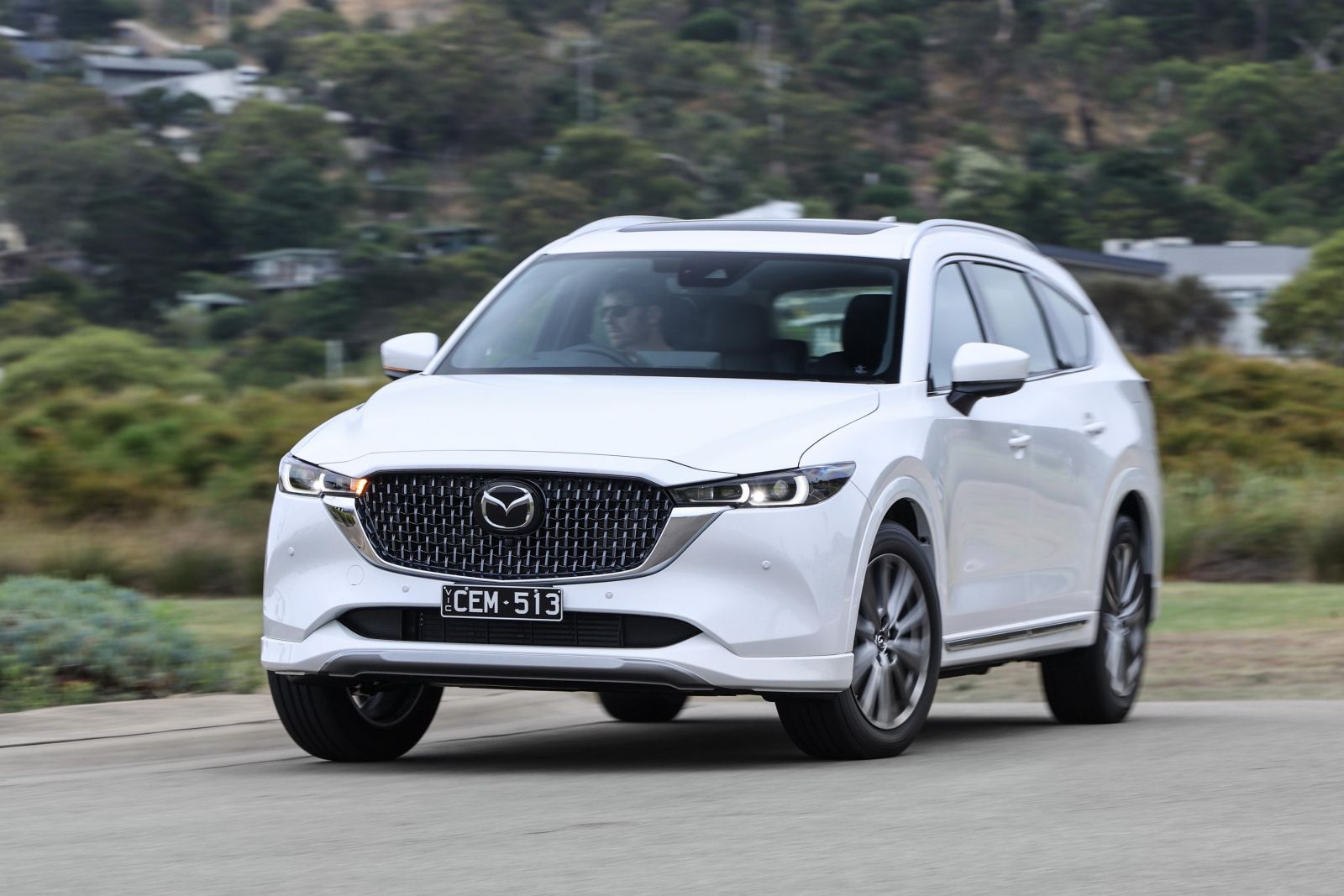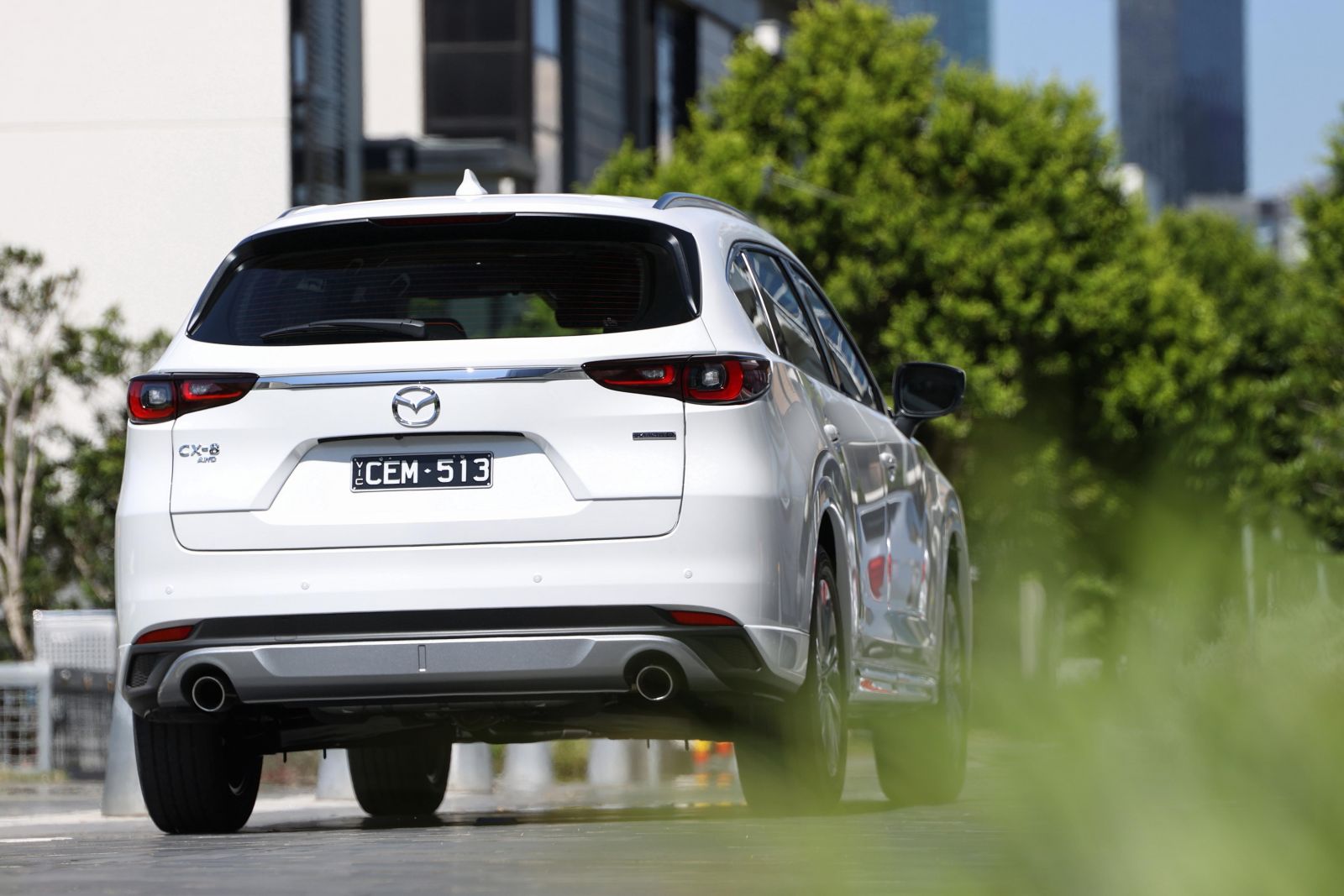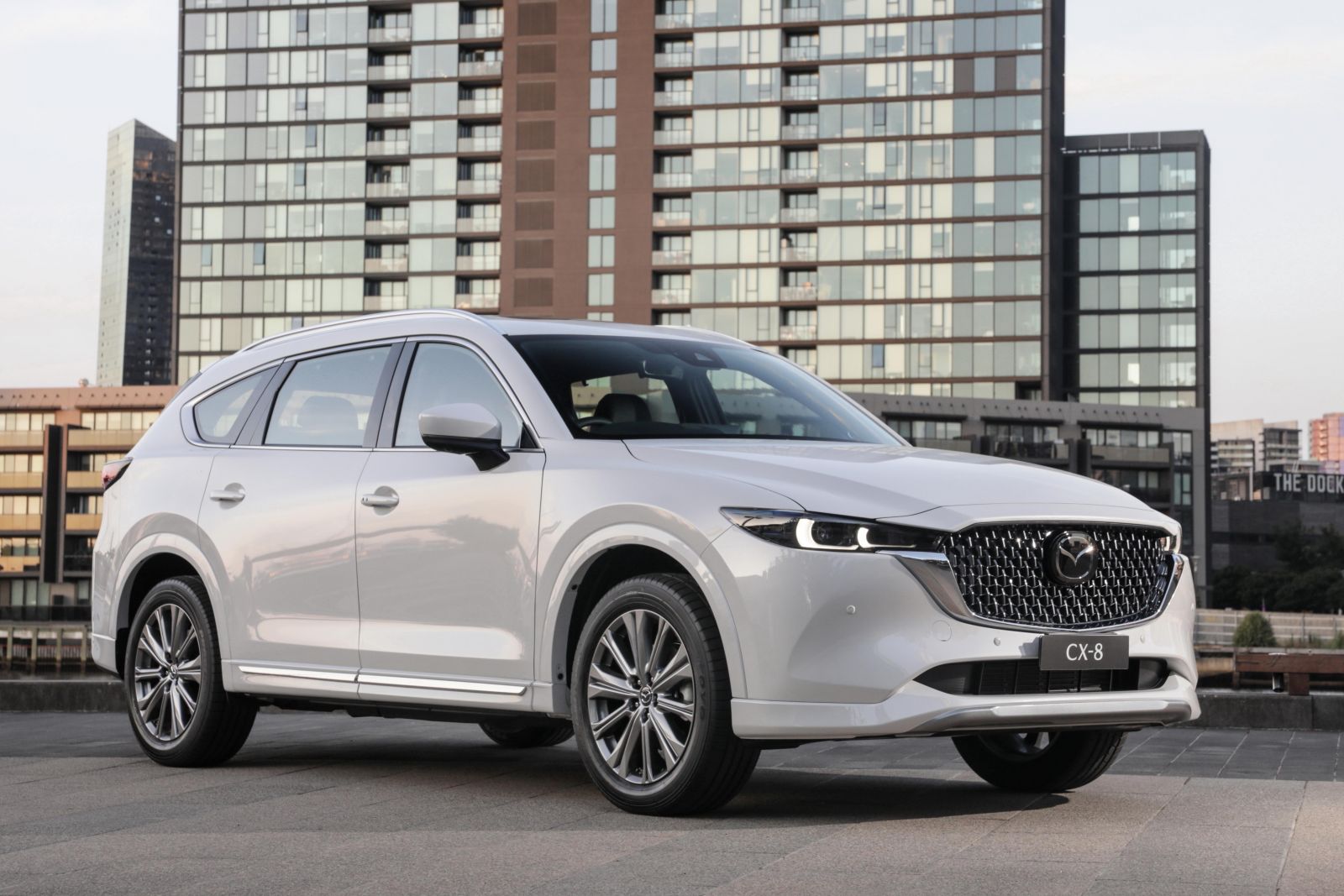There’s a lot of action in Mazda’s SUV range at the moment, with the all-new CX-60 and CX-90 on their way, the CX-9 on its way out and the top-selling CX-5 has recently been updated.
Now it’s the three-row Mazda CX-8’s turn for a little bit of attention; as it scores a subtle update that offers a few enhancements to the styling, some variant tweaks, and a potential new pick of the range for buyers after a really good value three-row SUV with diesel power and all-wheel drive.
Often described as the CX-5 with a bigger bum, the CX-8 actually has a lot more space than that label gives it credit for – it’s built on the same wheelbase as the outgoing CX-9, and that means it has immense levels of interior practicality, and heaps of child-seat fitment options to boot.
Have the changes to the CX-8 been enough to keep it competitive in the six- and seven-seat SUV segment? Read on to find out.
How much does the Mazda CX-8 cost?
The updated 2023 range has seen a number of adjustments to the line-up, including the addition of a Touring Active variant that your humble tester reckons is the pick of the pack in the updated line-up for those who are watching their pennies.
2023 Mazda CX-8 pricing:
- Mazda CX-8 G25 Sport FWD: $42,060 (+$1870)
- Mazda CX-8 G25 Touring FWD: $48,960 (+$1870)
- Mazda CX-8 D35 Sport AWD: $49,060 (+$1870)
- Mazda CX-8 D35 Touring Active AWD: $56,910 (NEW)
- Mazda CX-8 GT SP G25 FWD: $58,560 (NEW)
- Mazda CX-8 Asaki G25 FWD: $61,810 (+$1400)
- Mazda CX-8 GT SP D35 AWD: $65,560 (NEW)
- Mazda CX-8 Asaki D35 AWD: $68,810 (+$1400)
- Mazda CX-8 Asaki LE D35 AWD: $71,410 (+$1400)
Prices exclude on-road costs
You’ll notice that a lot of those prices are up, and there are a few new versions on offer. The aforementioned Touring Active slots in where the old Touring diesel was, while the GT SP grade essentially fills the shoes of the petrol and diesel Touring SP and GT models, which aren’t offered anymore.
The other new thing you might have noticed is the alphanumeric assigned to the petrol (G25) and diesel (D35) versions of the CX-8, which is in keeping with the other updated models in the Mazda line-up. The G25 is the same 2.5-litre atmo petrol as before, while the D35 is the carryover 2.2-litre twin-turbo diesel.
When it comes to rivals, there are plenty you might want to consider.
The Hyundai Santa Fe is pretty close on price, size and intent, with a range of petrol V6 FWD and four-cylinder turbo-diesel AWD models, and there’s also a petrol-electric hybrid AWD version which isn’t an option in the CX-8 line-up. Prices range from $46,050 to $69,550 before on-roads.
Another South Korean option is the Kia Sorento, which is arguably a better looking SUV than the others, and also has petrol FWD, diesel AWD, hybrid AWD and a plug-in hybrid AWD option. The prices are a bit higher, though, from $47,650 to $81,080.
There are other choices out there, obviously, but those two are the closest and best fits when it comes to alternatives. Or you could get a CX-9 and then you’d be able to have it with the excellent G35 turbo-petrol engine and all-wheel drive. Mmmmm.
What is the Mazda CX-8 like on the inside?
It might not look like there are many changes inside the cabin of the CX-8, but Mazda says the front seats have been redesigned for “enhanced support and comfort”, while there are new trim options across the line-up.
The Touring Active model gets the most interesting finish, called Revera Stone Maztex with grey cloth – and it looks classy but also stands out from the other models, which have planer finishes.
This grade and GT SP also get a 10-way power adjustable driver’s seat with memory settings (two), plus second-row outboard seat heating for those grades as well.
That said, the Nappa leather trim options have changed, with the Asaki grade getting black colouring, while the Asaki LE can be had with black or Pure White.
All grades now get a 7.0-inch digital instrument display integrated into the cluster, and there’s a head-up display in all models, too.
The CX-8 retains the same controls for climate and media below the screen, with lovely tactility to the buttons and dials, which are a refreshing (albeit old-school) element to the cabin in a segment that is seemingly increasingly becoming obsessed with touch-capacitive buttons or additional screens for those functions.
Every CX-8 now comes with the brand’s 10.25-inch Mazda Connect infotainment system, which is controlled by a rotary dial and buttons, or via voice control. It doesn’t have touch capability, and that’s the worst thing about it.
It means that using your smartphone functions is dumbed down by the extra layers of interaction required, and that’s even more insulting as the Apple CarPlay and Android Auto smartphone mirroring is now capable of wireless connectivity, too.
Keeping other devices charged is taken care of by a pair of USB-C ports up front, while all but the base model get a pair of USB-A ports in the fold-down armrest in the second row, and high-spec models add a further pair of ports for backseat bandits.
The storage on offer is good up front, with a pair of cupholders between the seats, a split-lid centre console bin, and there’s a wireless phone charger in GT SP and above. The door pockets include bottle holders, too.
Second-row storage includes the aforementioned flip-down armrest with cupholders, and dual-pocket seatback storage, plus there are bottle holders in the back doors, too.
Back seat comfort amenities include directional air-vents, and all models come with a third climate control zone with separate temperature adjustment. There’s a six-seat layout in the Azami LE with captain’s chairs and a larger console bin between the seats.
If you choose that grade you have ISOFIX and top-tethers in the window seats, while the other versions have an additional top-tether point for the middle seat. The child-seat fitment options don’t stop there, with an additional pair of top-tether points in the third-row.
The second-row seats slide 60:40 to offer those in the back row more space if needed, and I was able to position the middle row to have enough space for my 182cm/6’0” frame and still fit in the very back – well, my legs fit fine, anyway.
Admittedly, Mazda says that people up to 170cm should be able to fit, but as you’d expect, I struggled for headroom back there. Even so, it is roomier than you’d think, and there are cup holders at the sides of the space, too.
The third-row seats have easy fold-down levers that are a lot simpler and smarter than the pull-tab options fitted to other seven-seaters, and if you fold the back row seats down you get 775 litres of cargo capacity.
Leave them up, and there’s 207 litres available. That means you could fit a pram sitting upright, or a couple of school bags or shopping backs in there behind the back row.
There is a further 33 litres of cargo space under the boot floor, and further below you will find a space-saver spare wheel fitted in every grade, too.
What’s under the bonnet?
As mentioned above, you’ve got two choices.
G25 models come with a naturally-aspirated 2.5-litre four-cylinder petrol engine producing 140kW of power (6000rpm) and 252Nm of torque (4000rpm). That’s not a whole lot of grunt for an SUV that tips the scales at around 1800kg without anyone on board.
As such, it’s easy to see why the D35 is the standout engine option here – and remember, when the CX-8 first launched in Australia it was supposed to be a slightly different option for buyers who wanted a big seven-seater SUV but wanted diesel, because the CX-9 never offered that.
D35 models are powered by a 2.2-litre four-cylinder twin-turbo diesel engine producing 140kW (4500rpm) and 450Nm (2000rpm).
Both engine choices come exclusively with a six-speed automatic transmission. G25 models are front-wheel drive, while the D35 versions are all-wheel drive, and they’ve seen the inclusion of a new Off-Road mode that “intervenes to direct drive torque to the wheels that need drive torque and not others that might begin to lose traction and spin”.
Towing capacity for all grades is 750kg for unbraked trailers, while petrol models can tow a maximum braked load of 1800kg and diesel versions are rated for 2000kg braked towing capacity. Note: maximum towball download for all grades is 150kg.
How does the Mazda CX-8 drive?
The Mazda CX-8 has the brand’s signature driving manners and characteristics, which means it is going to be appealing for buyers who want a vehicle that makes them feel involved in the drive.
That is to say that the ride isn’t the most cushy or soft, especially in the versions with larger wheels and lower-profile tyres (the top-specs have 225/55 R19 tyres).
I had a quick spin in the base model G25 Sport with 17s and chubby-sidewall rubber (225/65 R17), and it felt notably less lumpy over repetitive bumps.
The steering also has that typical Mazda feel to it, which is a bit more feelsome and even a touch twitchy at times, especially if you encounter some bumps in the middle of a corner – you might feel the steering wheel jostle in your hands in that situation.
The good thing is that it is relatively easy to park even with the eager steering feel, though I think Mazda really should have a surround-view camera as standard on a car of this size – it’s more than 4.9 metres long, and Mazda has some of the worst side mirror vision on offer, which means it can be quite hard to see out of.
The tech is available, because it’s fitted to the expensive models, but it would be nice to see that sort of thing fitted to all grades in the range, given this is a family SUV and we’ve all seen those stories about driveway accidents.
Now, when it comes to engines, as I’ve alluded to, the diesel is the better of the two.
The D35 engine offers significantly more torque, which just makes the hard work easier when it comes to moving this large, heavy SUV around. It feels more relaxed in the way it builds speed, and it’s quieter in doing so, too.
The G25 isn’t terrible, but it does feel like it has to work hard. The engine is noisy, especially when you’re up it, and you will have to be up it a fair bit – because over our test drive there was plenty of undulating territory and the six-speed auto was kept busy to try and help the car maintain pace.
That said, not everyone drives on country roads and aims to stick right on the speed limit like motoring journalists do, and my short drive in the base model involved more ‘realistic’ slower speed driving that you might typically do in town or for the school drop-off. And in those situations, the G25 did the job expected of it.
What do you get?
CX-8 Sport highlights:
- 17-inch alloy wheels
- Automatic LED headlights
- Heated electric wing mirrors with auto-folding
- Rain-sensing wipers
- Head-up display
- Push-button start
- Tri-zone climate control
- Auto-dimming rear view mirror
- Leather-wrapped steering wheel and shifter
- 10.25-inch touchscreen infotainment system (NEW)
- USB-C charge ports (x2)
- Satellite navigation
- Apple CarPlay, Android Auto (wireless)
- DAB+ digital radio
- 6-speaker sound system
- Rear parking sensors
- Reversing camera
CX-8 Touring adds:
- LED fog lights
- Front parking sensors
- Keyless entry
- Black leather seat trim
- Heated front seats
- 8-way power driver’s seat
- 6-way power passenger’s seat
- USB ports for second row centre arm rest
- Paddle shifters
CX-8 Touring Active adds:
- 19-inch alloy wheels in black metallic with machined face
- LED daytime running lights
- Adaptive front lighting system
- Black exterior mirror caps
- Revera Stone Maztex and grey cloth interior
- 10-way power adjustment for driver’s seat
- Second-row outboard seat heating
CX-8 GT SP adds:
- 19-inch wheels in black metallic
- Gloss black grille
- Cruising and Traffic Support
- Black or Burgundy leather seat trim
- Rear door window shades
- Power tailgate (electric boot) with remote opening
- Sunroof
- 10-speaker Bose sound system
- Third-row USB-A charge ports
CX-8 Asaki adds:
- 19-inch wheels in bright silver
- Bright metallic grille
- Body-coloured mirror caps
- Body-coloured lower cladding
- Black Nappa leather seat trim with pattern stitching
- Cooled front seats (ventilated)
- 360-degree camera system
CX-8 Asaki LE adds:
- Black or Pure White Nappa leather seat trim with quilting
- 6-seat interior with second-row captain’s chairs
- Second-row power seat adjustment
- Cooled second-row seats (ventilated)
- Centre console and USB charging (second row)
Is the Mazda CX-8 safe?
The Mazda CX-8 scored a five-star ANCAP safety rating in 2018.
It scored 96 per cent for adult occupant protection, 87 per cent in child occupant protection, 72 per cent in vulnerable road user protection, and 73 per cent in safety assist.
Standard safety equipment includes:
- Adaptive cruise control with stop/go
- AEB with Pedestrian detection (front)
- AEB evers
- Blind-spot monitoring
- Rear cross-traffic alert
- Lane-keep assist
- Driver attention alert
- Traffic sign recognition
- Intelligent Speed Assistance
- Rear parking sensors
- Reversing camera
- Tyre pressure monitoring
- Auto high-beam
Higher-end models have front parking sensors (Touring and above) and adaptive front lighting (Touring Active and GT SP), while the Asaki and Asaki LE models have adaptive LED headlights.
If you want a 360-degree surround-view camera, Mazda asks you to spend up to the Asaki grade at least, which is disappointing considering the size and visibility on offer in this large SUV.
In this writer’s opinion, that technology should be fitted as standard, because these sorts of cars are bought by the very people you read about in those horror stories about driveway back-over accidents, and not everyone can afford more than $60k for their SUV.
How much does the Mazda CX-8 cost to run?
Mazda offers a five-year, unlimited-kilometre warranty for its model line-up in Australia, and there’s five years of roadside assistance included, too.
Capped-price servicing is offered, though there is a difference in price and service intervals for the petrol and diesel models.
G25 versions have intervals set at 12 months/15,000km, while the D35 requires maintenance more regularly, with intervals pegged at 12 months/10,000km. That’s not only inconvenient, it also means you’ll end up paying a whole lot more just to keep your diesel CX-8 on the road.
For instance, the servicing costs for the first five maintenance visits for the petrol average out to $433 per visit, while the diesel is pricier, averaging out to $488 per go – and remember, that’s only for 50,000km, not 75,000km as in the petrol.
G25 models quote an official combined cycle fuel use figure of 8.1L/100km, while D35 models quote 6.0L/100km.
The launch drive for the CX-8 update consisted mainly of country roads in rural Victoria, after which the trip computer of the G25 was reading 10.7L/100km, even with only two occupants on board. The D35 diesel’s engine made it for easier work, and a lower 8.4L/100km readout for similar driving.
Buy the petrol and you get a 72-litre fuel tank (compatible with 91 RON regular unleaded), while the diesel has a slightly larger 74L tank.
CarExpert’s Take on the Mazda CX-8
The Mazda CX-8 remains a solid option for buyers looking for a properly practical six- or seven-seat SUV with lots of family-friendly features.
The diesel makes it an easier car to live with, and the D35 Touring Active ticks a lot of boxes in terms of features.
But if you’re on a really tight budget, the base G25 Sport could be a surprise special, given it gets the smaller alloys and a smoother ride as a result.
Click the images for the full gallery
MORE: Everything Mazda CX-8



















